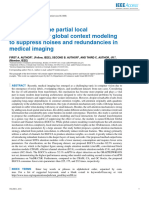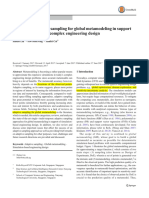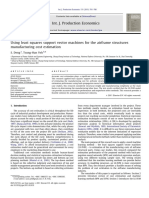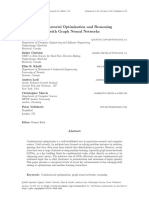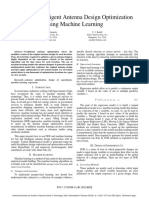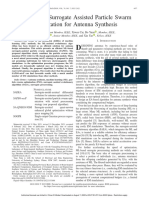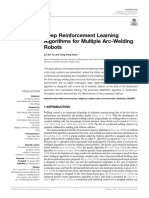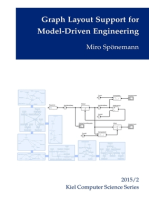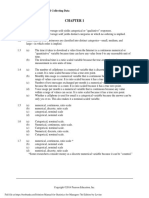An Ai Assisted Design Method For Topology Optimization Without Pre Optimized Training Data
An Ai Assisted Design Method For Topology Optimization Without Pre Optimized Training Data
Uploaded by
mahesh varada.sCopyright:
Available Formats
An Ai Assisted Design Method For Topology Optimization Without Pre Optimized Training Data
An Ai Assisted Design Method For Topology Optimization Without Pre Optimized Training Data
Uploaded by
mahesh varada.sOriginal Title
Copyright
Available Formats
Share this document
Did you find this document useful?
Is this content inappropriate?
Copyright:
Available Formats
An Ai Assisted Design Method For Topology Optimization Without Pre Optimized Training Data
An Ai Assisted Design Method For Topology Optimization Without Pre Optimized Training Data
Uploaded by
mahesh varada.sCopyright:
Available Formats
INTERNATIONAL DESIGN CONFERENCE – DESIGN 2022
https://doi.org/10.1017/pds.2022.161
An AI-Assisted Design Method for Topology Optimization without
Pre-Optimized Training Data
A. Halle , L. F. Campanile and A. Hasse
Chemnitz University of Technology, Germany
alex.halle@mb.tu-chemnitz.de
Abstract
Engineers widely use topology optimization during the initial process of product development to obtain a
first possible geometry design. The state-of-the-art method is iterative calculation, which requires both time
and computational power. This paper proposes an AI-assisted design method for topology optimization,
which does not require any optimized data. The presented AI-assisted design procedure generates
geometries that are similar to those of conventional topology optimizers, but require only a fraction of the
computational effort.
Keywords: topology optimisation, AI-assisted design, computational design methods,
design evaluation, design to x (DtX)
1. Introduction
The presented paper deals with the solution of optimization problems by means of artificial
intelligence (AI) techniques. Topology optimization (TO) was chosen as an application example, even
though the described method is applicable to many optimization problems and thus has generality.
TO is a method of optimizing the geometry of structures. In TO, the material distribution over a given
design domain is the subject of optimization, i.e. minimization of a given objective function while
satisfying given constraints (Sigmund and Maute, 2013). In most cases, suitable search algorithms
solve the optimization problem mathematically.
The combination of AI and TO in the state-of-the-art research mostly requires optimized geometries
generated by conventional TO or FEM results as a basis for training. For this reason, they are subject
to several limitations that affect those techniques, such as large computational effort and the need to
prepare representative data.
The approach proposed here aims at removing those drawbacks by generating all the artificial
knowledge required for optimization during the learning phase, with no need to rely on pre-optimized
results.
1.1. Topology Optimization
In this work, only the case of mono-material topology optimization is considered. The material of
which the structure is to be build is a constant of the problem, and the geometry remains unknown.
The function to be minimized in stiffness optimization is usually the scalar measure of structural
compliance. In addition, the filling degree condition must be fulfilled. This filling degree corresponds
to the fraction of the maximum possible amount of material (degree of filling) which is to be used in
the design and is often also referred to as the volume fraction. Typically considered restrictions are the
ARTIFICIAL INTELLIGENCE AND DATA-DRIVEN DESIGN 1589
https://doi.org/10.1017/pds.2022.161 Published online by Cambridge University Press
available design domain, the static and kinematic boundary conditions for the regarded load cases as
well as strength thresholds.
There are numerous possible approaches to TO (Sigmund and Maute, 2013). According to the "Solid
Isotropic Material with Penalization" (SIMP) approach of Bendsøe (Bendsøe and Sigmund, 2003), a
subdivision of the design domain into elements takes place. A factor, yet to be determined, scales the
contribution of each element to the overall stiffness of the structure.
The SIMP approach is able to provide optimized geometries for many practical cases by means of an
iterative process. Each iteration involves computationally intensive operations: the most critical ones are
assembling the stiffness matrix and solving the system's equation. The involvement of restrictions, such as
stress restrictions, increases the complexity of the optimization problem (Lee, 2012; Picelli et al., 2018).
1.2. Artificial Neural Networks
Artificial neural networks (ANNs) belong to the area of machine learning (ML), which, in turn, is
assigned to AI. ANNs are able to learn and execute complex procedures, which has led to remarkable
results in recent years. ANNs or, more precisely, feedforward neural networks, consist of layers
connected in sequence. These layers contain so-called neurons (Karayiannis and Venetsanopoulos,
1993). A neuron is the basic element of an ANN. The combination of all layers is called a network.
The neurons receive inputs, which are linearly combined and added to a bias value and passed as
argument to an activation function. The coefficients of the linear combination are called weights. The
weights and bias are also sometimes referred to as the trainable parameters.
It is usual that several neurons have the same input. All neurons with the same inputs are grouped
together in one layer (also called fully connected layer). The number of layers is also named depth of the
network, which also originates the attribute "deep" in the term deep learning (DL).
More details about the learning of an ANN can be found in literature, for example in (Basheer and
Hajmeer, 2000; Goodfellow et al., 2016; James et al., 2021; Mohammed et al., 2016).
1.3. Deep Learning-Based Topology Optimization
In the current state of research, there are several publications dealing with ML in the field of TO. Most of
these use conventionally topology-optimized geometries (Abueidda et al., 2020; Ates and Gorguluarslan,
2021; Malviya, 2020; Nie et al., 2021; Rawat and Shen, 2019; Yu et al., 2019) for the training of the
ANN. The ANNs learned to provide a geometry for specific boundary conditions that has similarities to
the training data. As a consequence, the underlying mathematical relationship between the inputs and
geometry, such as compliance, was not explicitly part of the training, which was merely data-driven.
Thus, while these methods are able to provide directly nearly optimal geometries, they can also produce
not interpretable results, such as disconnected structures.
Alternative approaches establish ML as part of the iterative topology optimization process to reduce
computation time by partially replacing some of the FEM algorithms with ML algorithms (Behzadi and
Ilies, 2021; Chi et al., 2021; Kallioras et al., 2020; Qian and Ye, 2020; Sosnovik and Oseledets, 2017;
Yamasaki et al., 2021; Zhang et al., 2019). Even though these approaches sometimes reduce the
computation time considerably, they often have to be trained again for new boundary conditions/inputs.
This paper investigates the possibility, which differs from the state-of-the-art methods, to train an ANN
without the use of optimized or computationally prepared data. The generation of training data points
and the training itself are merged in one single procedural step.
2. Method
The presented method is based on an ANN architecture called predictor-evaluator-network (PEN), which
was developed by the authors for this purpose. The predictor is the trainable part of the PEN and its task
is to generate, based on input data, optimized geometries.
As mentioned, unlike the state-of-the-art methods, no conventionally topology-optimized or
computationally prepared data are used in the training. The geometries used for the training are created
by the predictor itself on the basis of randomly generated input data and evaluated by the remaining
components of the PEN, called evaluators (see Figure 1).
1590 ARTIFICIAL INTELLIGENCE AND DATA-DRIVEN DESIGN
https://doi.org/10.1017/pds.2022.161 Published online by Cambridge University Press
Evaluators
Evaluator 2
Quality function
Input Data Predictor Evaluator 1 M
Minimization
Output Data
Figure 1. The basic principle of the Predictor-Evaluator-Network (PEN)
The evaluators perform mathematical operations. Other than the predictor, the operations performed
by the evaluators are pre-defined and do not change during the training.
Each evaluator assesses the outputs of the predictor with respect to a certain criterion and returns a
corresponding scalar value as a measure of the criterion's fulfillment. The deviation from the
fulfillment of the considered criterion is the loss or the error of this evaluator.
A scalar function of the evaluator outputs (the quality function) combines the individual losses. During
the training, the objective function computed for a set of geometries (batch) is minimized by changing
the predictor's trainable parameters. In this way, the predictor learns how to produce optimized
geometries.
2.1. Basic Definitions
In topology optimization, the design domain is typically subdivided into elements by appropriate
meshing. Figure 2 visualizes the elements (with one element hatched) and nodes.
Figure 2. Design space overview with elements, nodes and dimension 𝒅 (square case)
In this work, we examined only square meshes with equal numbers of rows and columns. However,
this method can be used for non-square and three-dimensional geometries.
The total number of elements is as follows:
𝑛 = 𝑑𝑥 𝑑𝑦 (1)
where 𝑑𝑦 is the number of rows and 𝑑𝑥 the number of columns (see Figure 2). In the square case, the
number of rows and columns are equal (𝑑𝑥 = 𝑑𝑦 = 𝑑), so that the total number of elements is 𝑑2 .
The 𝑑2 design variables 𝑥𝑖 {𝑖 = 1, … , 𝑑2 }, termed density values, scale the contributions of the single
elements to the stiffness matrix. The density has a value of one when the stiffness contribution of the
element is fully preserved and zero when it disappears.
The density values are collected in a vector 𝐱. In general, the density values 𝑥𝑖 are defined in the
interval [0, 1]. In order to prevent possible singularities of the stiffness matrix, a lower limit value
𝑥min for the entries of 𝐱 is set as follows (Bendsøe and Sigmund, 2003):
0 < 𝑥min ≤ 𝑥𝑖 < 1, 𝑖 = 1,2, … , 𝑑 2 . (2)
Although a binary selection of the density is desired (discrete TO, material present/not present), values
between zero and one are permitted for algorithmic reasons (continuous TO). To get closer to the
desired binary selection of densities, the so-called penalization can be used in the calculation of the
compliance. The penalization is realized by an element-wise exponentiation of the densities by the
penalization exponent 𝑝 > 1 (Sigmund, 2001).
The arithmetic mean of all 𝑥𝑖 defines the degree of filling of the geometry as follows:
1 2
𝑀is = ∑𝑑𝑖=1 𝑥𝑖 (3)
𝑑2
ARTIFICIAL INTELLIGENCE AND DATA-DRIVEN DESIGN 1591
https://doi.org/10.1017/pds.2022.161 Published online by Cambridge University Press
The target value 𝑀tar is the degree of filling that is to be achieved by the predictor.
Investigations showed that the training speed (see section 2.8) could be increased, for high-resolution
geometries, by dividing the training into levels with increasing resolution. Since smaller geometries
are trained several orders of magnitude faster and the knowledge gained is also used for higher
resolution geometries, the overall training time is reduced, compared to the training that uses only
high-resolution geometries. The levels are labeled with the integer number Λ.
Increasing Λ by one results in doubling the number 𝑑 of rows or columns of the design domain's mesh.
This is done by quartering the elements of the previous level. In this way, the nodes of the previous
level are kept in the new level. The number of row or columns at the first level is denoted as 𝑑inp.
Figure 3. Nodes and elements at different levels 𝚲 (resolutions). The boundary conditions do
not change
Input data can be only defined at the initial level and do not change when the level is changed. Hence,
new nodes cannot be subject to static or kinematic boundary conditions (see Figure 3). When the level
is changed, only the dimension of the outputs changes; the dimension of the inputs remains constant.
The change in level occurs after a certain condition, which will be described later, is fulfilled.
2.2. Predictor
The predictor is responsible for generating, after training, the optimized result for a given input data
point. Its ANN-architecture consists of multiple hidden layers, convolutional layers and output layers.
All parameters that can be changed during training in order to minimize the target function, such as
the bias and the weights of the hidden layers, are generally referred to as trainable parameters in the
following. The predictor's topology is shown in Figure 4 in a simplified form.
sigmoid
ResNet
ResNet
ResNet
hidden
hidden
output
block
block
block
block
block
input Λ=
…
data
Avarage
sigmoid
Pooling
activation
output
activation
activation
hidden
Λ=
conv.
conv.
layer
layer
layer
add
Λ=2
hidden ResNet
block block Λ=1
Figure 4. Predictor’s artificial neural network (ANN) topology (simplified)
An input data (top left) is processed by several successive hidden blocks and then passed on to some
ResNet-blocks. A hidden block is a combination of a hidden layer and an activation. ResNet-blocks
consist of multiple convolutional and activation layers (He et al., 2016) (see Figure 4). At this stage,
the output is at the highest resolution. The sigmoid function is well suited as an activation function for
the output layer because it provides results in the interval (0, 1). This makes the predictor's output
directly suitable to describe the density values of the geometry. Average pooling is used in order to
reduce the resolution to a lower level Λ.
1592 ARTIFICIAL INTELLIGENCE AND DATA-DRIVEN DESIGN
https://doi.org/10.1017/pds.2022.161 Published online by Cambridge University Press
2.3. Evaluator: Compliance
The task of the compliance evaluator is the computation of the global mean compliance. For this
purpose, an algorithm based on FEM (Sigmund, 2001) is used. The compliance
𝑐 = 𝐔 𝑇 𝐊𝐔 = 𝐔 𝑇 𝐅 (4)
can be calculated using the stiffness matrix 𝐊, the forces 𝐅 and the displacements 𝐔. The stiffness
matrix is linearly dependent on the geometry 𝐱 and is defined as follows:
2
𝑝
𝐊 = ∑𝑑𝑖=1 𝑥𝑖 𝐊 𝑖 (5)
Where 𝑝 is the penalization parameter and 𝐊 𝑖 is the unscaled element stiffness matrix. As is usual in
(Andreassen et al., 2011; Sigmund, 2001), in the following, the units will be omitted for the sake of
simplicity.
2.4. Evaluator: Degree of Filling
The task of this evaluator is to determine the deviation of the degree of filling 𝑀is (see (3)) from the
target value 𝑀tar as follows:
𝑀 = |𝑀tar − 𝑀is | (6)
By considering the filling degree's deviation 𝑀 in the objective function, the predictor is penalized
proportionally to the extent of the deviation from the target degree of filling 𝑀tar .
2.5. Evaluator: Filter
The filter evaluator searches for checkerboard patterns in the geometry and outputs a scalar value 𝐹
that points to the amount and extent of checkerboard patterns detected. These checkerboard patterns
consist of alternating high and low density values of the geometry. They are undesirable because they
are difficult to transfer to real parts. These checkerboard patterns exist due to bad numerical modeling
(Díaz and Sigmund, 1995).
Several solutions for the checkerboard problem were developed in the framework of conventional
topology optimization (Sigmund and Petersson, 1998). In this work, a new strategy was chosen, which
allows for inclusion of the checkerboard filter into the quality function. In the present approach,
checkerboard patterns are admitted but detected and penalized accordingly.
Since the type of implementation is fundamentally different, it is not possible to compare the
conventional filter methods with the filter evaluator.
2.6. Evaluator: Uncertainty
When calculating the density values of the geometry 𝐱, the predictor should, as far as possible, focus
on the limit values 𝑥min and 1 and penalize intermediate values. The deviation from this goal is
expressed by the uncertainty evaluator with the scalar variable 𝑃. This value increases if the predicted
geometry deviates significantly from the limit values and thus penalizes the predictor. This approach
differs from the conventional penalization approach: conventional penalization has a direct influence
on the compliance. The presented approach only influences the objective function in the form of an
evaluation. For this reason the penalization factor (see (5)) is set to 𝑝 = 1 for the training.
2.7. Quality Function and Objective Function
The quality function combines all evaluator values into one scalar. In general, the following formula is
used:
𝑓𝑄 = ∏𝑛𝑖=1(𝛼𝑖 𝐸𝑖 + 1), (7)
where 𝐸𝑖 represents an evaluator output, 𝛼𝑖 is the corresponding weighting factor and 𝑛 is the total
number of evaluators. Using the presented evaluators, this equation becomes
𝑓𝑄 = (𝛼𝑐 + 1)(𝛽𝑀 + 1)(𝛾𝐹 + 1)(𝛿𝑃 + 1). (8)
ARTIFICIAL INTELLIGENCE AND DATA-DRIVEN DESIGN 1593
https://doi.org/10.1017/pds.2022.161 Published online by Cambridge University Press
Since the training based on single geometries requires large computational effort and would lead to
instabilities of the training process (large jumps of the objective function output), a given number of
geometries (batch) is predicted and the corresponding quality functions are combined to one scalar
value, which acts as the objective function for the optimization determining the training.
During the training 𝛼, 𝛽, 𝛾 and 𝛿 have the values 2, 5, 1 and 1 respectively.
2.8. Training
Within one batch, the input data points are randomly generated, and the predictor creates the
corresponding geometries 𝐱. Afterwards, the quality function is computed from the evaluators' losses.
The value of the objective function is then calculated for the whole batch. Then, the gradient of the
objective function, with respect to the trainable parameters, is calculated. The trainable parameters of
the predictor for the next batch are then adjusted according to the gradient descent method to decrease
the value of the objective function. In order to apply the gradient descent method, the functions must
be differentiable with respect to the trainable parameters (Kingma and Ba, 2017). For this reason, the
evaluators and the objective function use only differentiable functions.
When the level increases, the predictor outputs a geometry with higher resolution, and the process
starts again.
It is important to stress that, unlike conventional topology optimization, the PEN method does not
optimize the density values of the geometry, but only the weights of the predictor.
3. Application
3.1. Implementation
The implementation of the presented method takes place in the programming language Python. The
framework Tensorflow with the Keras programming interface is used. Tensorflow is an open-source
platform for the development of machine-learning applications (Abadi et al., 2015). In Tensorflow, the
gradients necessary for the predictor learning are calculated using automatic differentiation, which
requires the use of {differentiable} functions available in Tensorflow (Baydin et al., 2015).
The predictor's topology, with all layers and all hyperparameters, is shown in Figure 5. The chosen
hyperparameters were found to be the best after a grid search of all parameters in which the deviations
of the predictions from the ones obtained by conventional TO were evaluated. The hyperparameters
are displayed by the shape (numerical expression over the arrow pointing outside the block) of the
output matrix of a block or by the comment near the convolutional block. The label of the output
arrow describes the dimensions of the output vector or matrix. The names of the shapes in Figure 5,
e.g. "Conv2D", correspond to the Keras layer names.
UpSampling2D
Concatenae
1 2 1 2
Normalization
Channelwise
Reshape
Pooling2D
ResNet
ResNet
ResNet
Avarage
Avarage
hidden
hidden
hidden
PReLU
Sigmoid
block
block
block
block
block
block
Batch
25
Λ=
1
25
12
20
Output
1
1
2
Channelwise
Pooling2D
Avarage
Avarage
Sigmoid
Output 2
2
Λ=
2
input shape
(height width channels)
Channelwise
input shape
Pooling2D
A: Conv2D
12
Avarage
Avarage
Sigmoid
Λ=2
Output 1
LeakyReLU
1
Dense
hidden Batch ResNet B: Conv2D
1
block Normalization block
PReLU Add
Channelwise
20
Pooling2D
output shape
Avarage
Avarage
Sigmoid
LeakyReLU
Λ=1
Output
output shape
(height width channels)
Figure 5. Predictor's artificial neural network (ANN) architecture
1594 ARTIFICIAL INTELLIGENCE AND DATA-DRIVEN DESIGN
https://doi.org/10.1017/pds.2022.161 Published online by Cambridge University Press
As already mentioned, the training of the predictor is based on randomly generated input data sets. All
randomly chosen input data are uniformly distributed in the corresponding interval. They are
generated according to the following features:
Kinematic boundary conditions 𝐫k
o Fixed degrees of freedom along the left side in 𝑥- and 𝑦-directions.
Static boundary condition 𝐫s
o Position randomly chosen among all nodes (except the nodes that have a fixed degree of
freedom) of level one.
o Randomly chosen direction in the interval [0°, 0°]
o Fixed magnitude
Target degree of filling 𝑀tar
o Randomly chosen direction in the interval [0.2,0. ]
3.2. Results
The training of the predictor lasted 3.25 h (3:15:56), which can be subdivided according to the
individual levels as follows: 16%, 7%, 42%, 35%. The training processed approximately 7.6 million
randomly generated training data points. As expected, the training time increases proportionally with
the size of the geometry. While the first level processed over 3400 data points per second (𝑑𝑝𝑠), it
became less with each level (928 𝑑𝑝𝑠, 2 𝑑𝑝𝑠, 𝑑𝑝𝑠). This is due to the additional computational
effort and the need to reduce the batch size due to higher memory requirements with higher levels at
constant available memory.
The training history shows the progression of the objective function (see Figure 6). The smaller batch
size at higher levels produces more oscillation of the curve and therefore, makes it difficult to identify
a trend. For this reason, the curves shown in the figures are filtered, using the exponential moving
average and a constant smoothing factor of 0.873 (Nicolas, 2017) for all levels. This filtering does not
affect the original objective function and serves only visual purposes.
Figure 6. Progression of the objective function value during training
The dashed vertical lines (labeled with the value of Λ) in Figure 6 indicate the change in level. It can
be seen that the objective function value improves significantly in the first level 𝛬 and in the following
levels only slightly. The reason for this is that learning in one level optimizes the resolution in
subsequent levels as well.
The results were validated using 100 optimization problems. The input data for validation was
randomly generated and not used for training. The corresponding optimized geometries were
conventionally calculated by the top88 algorithm by (Andreassen et al., 2011).
The results of the comparison (PEN and top88) of the 100 validation data points are summarized in the
plots in Figure 7.
On average, the ANN-based TO can deliver almost the same result as the conventional method in
about 5.2 ms, while the conventional topology optimizer according to (Andreassen et al., 2011)
requires, on average, 1.9 s (and is, therefore, roughly 364 times slower); see Figure 7 (left). It can also
be seen that the majority of geometries generated by PEN have a compliance that is close to the
ARTIFICIAL INTELLIGENCE AND DATA-DRIVEN DESIGN 1595
https://doi.org/10.1017/pds.2022.161 Published online by Cambridge University Press
geometries generated by top88; see Figure 7 (middle). The geometries deviate in the degree of filling
to about one percent; see Figure 7 (right).
Figure 7. Computing time (left) and compliance (middle) and degree of filling (right)
comparison
The examples in Figure 8 show that the predictor can deliver geometries that are similar to the
conventional method, as well as some weaknesses. For instance, some geometries lack details (see
Figure 8, column four or five). This may be improved by an appropriate choice of layers or
hyperparameters of the predictor and by adapting the quality function. For all sample geometries in
Figure 8, the compliance is reported under the geometry diagram.
Figure 8. Sample geometries: a) generated with predictor–evaluator network (PEN), b)
conventionally generated validation data
It was mentioned that the PEN method is orders of magnitude faster than top88 in predicting
geometries. However, the predictor profits from a computationally intensive training. If this training
has to be performed globally once, and the topology optimization application is based on this trained
predictor, the training time for the end users can be effectively neglected.
3.3. Interactivity
Due to the ability to quickly obtain the optimized geometry by the predictor, the ANN-based TO can be
executed interactively in the browser. Under the address: https://www.tu-chemnitz.de/mb/mp/forschung/ai-
design/TODL/ (accessed on 22 February 2022), it is possible to perform investigations with different degrees
of filling as well as static boundary conditions.
4. Conclusions
In this work, a method was presented to train an ANN using online deep learning and use it to solve
optimization problems. In the context of the paper, Topology optimization (TO) was chosen as the
1596 ARTIFICIAL INTELLIGENCE AND DATA-DRIVEN DESIGN
https://doi.org/10.1017/pds.2022.161 Published online by Cambridge University Press
problem to be solved. The ANN in charge of generating topology-optimized geometries does not need
any pre-optimized data for the training. The generated geometries are, in most cases, very similar to
the results of conventional topology optimization, according to (Andreassen et al., 2011).
This topology optimizer is much faster, due to the fact that the computationally intensive part is
shifted into the training. After the training, the artificial neural network based topology optimizer is
able to deliver geometries that are nearly identical to the ones generated by conventional topology
optimizers (top88 was used as mathematical optimization algorithm). This is achieved by using a new
approach: the predictor-evaluator-network (PEN) approach. PEN consists of a trainable predictor that
is in charge of generating geometries, and evaluators that have the purpose of evaluating the output of
the predictor during the training.
The method was tested for the 2D case up to an output resolution of . This choice is not a
limitation of the method and can be improved by using better hardware for training or by high-
performance computing. The use of the method for the 3D case and higher resolutions is conceivable.
For this, the predictor would have to output a 3D geometry and the evaluator for compliance would
have to be adapted for the 3D case. The optimization of the computational efficiency of the training
phase was not the first priority of this project since the training is performed just once and, therefore,
affects the performance of the method only in a limited fashion.
A critical step is the calculation of the displacements in the compliance evaluator. The use of faster
algorithms (e.g., sparse solvers) could remove the mentioned limitations. One approach to improve the
learning process would be to train only in areas where there is a high potential for improvement,
through appropriate selection of training data points.
The results of the PEN method are comparable to the ones of the conventional method. However, the
PEN method could prove superior in handling applications and optimization problems of higher
complexity, such as stress limitations, compliant mechanisms and many more. This expectation is
related to the fact that no optimized data are needed. All methods that process pre-optimized data
suffer from the difficulties encountered by conventional optimization, while managing the above-
mentioned problems. Because the PEN method works without optimized data, it could also be applied
to problems that have no optimal solutions or solutions that are hard to calculate, such as the fully
stressed truss optimization.
To date, variable kinematic boundary conditions have not been tested. This will be done in future
research, together with resolution improvement and application to three-dimensional design domains
and different optimization problems.
References
Abadi, M., Agarwal, A., Barham, P., Brevdo, E., Chen, Z., Citro, C., Corrado, G.S., et al. (2015), “TensorFlow:
Large-Scale Machine Learning on Heterogeneous Distributed Systems”, ArXiv:1603.04467 [Cs], available
at: https://www.tensorflow.org/.
Abueidda, D.W., Koric, S. and Sobh, N.A. (2020), “Topology optimization of 2D structures with nonlinearities
using deep learning”, Computers & Structures, Vol. 237, p. 106283.
Andreassen, E., Clausen, A., Schevenels, M., Lazarov, B.S. and Sigmund, O. (2011), “Efficient topology
optimization in MATLAB using 88 lines of code”, Structural and Multidisciplinary Optimization, Vol. 43
No. 1, pp. 1–16.
Ates, G.C. and Gorguluarslan, R.M. (2021), “Two-stage convolutional encoder-decoder network to improve the
performance and reliability of deep learning models for topology optimization”, Structural and
Multidisciplinary Optimization, available at:https://doi.org/10.1007/s00158-020-02788-w.
Basheer, I.A. and Hajmeer, M. (2000), “Artificial neural networks: fundamentals, computing, design, and
application”, Journal of Microbiological Methods, Vol. 43 No. 1, pp. 3–31.
Baydin, A.G., Pearlmutter, B.A., Radul, A.A. and Siskind, J.M. (2015), “Automatic differentiation in machine
learning: a survey”, ArXiv:1502.05767 [Cs, Stat], available at: http://arxiv.org/abs/1502.05767 (accessed 23
September 2019).
Behzadi, M.M. and Ilies, H.T. (2021), “GANTL: Towards Practical and Real-Time Topology Optimization with
Conditional GANs and Transfer Learning”, Journal of Mechanical Design, pp. 1–32.
Bendsøe, M.P. and Sigmund, O. (2003), Topology Optimization: Theory, Methods, and Applications, Springer,
Berlin; Heidelberg; New York.
ARTIFICIAL INTELLIGENCE AND DATA-DRIVEN DESIGN 1597
https://doi.org/10.1017/pds.2022.161 Published online by Cambridge University Press
Chi, H., Zhang, Y., Tang, T.L.E., Mirabella, L., Dalloro, L., Song, L. and Paulino, G.H. (2021), “Universal
machine learning for topology optimization”, Computer Methods in Applied Mechanics and Engineering,
Vol. 375, p. 112739.
Díaz, A. and Sigmund, O. (1995), “Checkerboard patterns in layout optimization”, Structural Optimization, Vol.
10 No. 1, pp. 40–45.
Goodfellow, I., Bengio, Y. and Courville, A. (2016), Deep Learning, The MIT Press, Cambridge, Massachusetts,
available at: http://www.deeplearningbook.org.
He, K., Zhang, X., Ren, S. and Sun, J. (2016), “Deep Residual Learning for Image Recognition”, 2016 IEEE
Conference on Computer Vision and Pattern Recognition (CVPR), presented at the 2016 IEEE Conference
on Computer Vision and Pattern Recognition (CVPR), pp. 770–778.
James, G., Witten, D., Hastie, T. and Tibshirani, R. (2021), An Introduction to Statistical Learning: With
Applications in R, Springer US, New York, NY, available at:https://doi.org/10.1007/978-1-0716-1418-1.
Kallioras, N.Ath., Kazakis, G. and Lagaros, N.D. (2020), “Accelerated topology optimization by means of deep
learning”, Structural and Multidisciplinary Optimization, Vol. 62 No. 3, pp. 1185–1212.
Karayiannis, N.B. and Venetsanopoulos, A.N. (1993), Artificial Neural Networks: Learning Algorithms,
Performance Evaluation, and Applications, Kluwer Academic, Boston.
Kingma, D.P. and Ba, J. (2017), “Adam: A Method for Stochastic Optimization”, ArXiv:1412.6980 [Cs],
available at: http://arxiv.org/abs/1412.6980 (accessed 12 February 2020).
Lee, E. (2012), Stress-Constrained Structural Topology Optimization with Design-Dependent Loads, University
of Toronto, September, available at: https://tspace.library.utoronto.ca/handle/1807/32254.
Malviya, M. (2020), A Systematic Study of Deep Generative Models for Rapid Topology Optimization, preprint,
engrXiv, available at:https://doi.org/10.31224/osf.io/9gvqs.
Mohammed, M., Khan, Muhammad Badruddin, and Bashier, Eihab Bashier Mohammed. (2016), Machine
Learning : Algorithms and Applications, CRC Press, available at:https://doi.org/10.1201/9781315371658.
Nicolas, P.R. (2017), Scala for Machine Learning - Second Edition, Packt Publishing, Limited, Birmingham,
UNITED KINGDOM, available at: http://ebookcentral.proquest.com/lib/tuchemnitz/detail.action?
docID=5061334.
Nie, Z., Lin, T., Jiang, H. and Kara, L.B. (2021), “TopologyGAN: Topology Optimization Using Generative
Adversarial Networks Based on Physical Fields Over the Initial Domain”, Journal of Mechanical Design,
Vol. 143 No. 3, p. 031715.
Picelli, R., Townsend, S., Brampton, C., Norato, J. and Kim, H.A. (2018), “Stress-based shape and topology
optimization with the level set method”, Computer Methods in Applied Mechanics and Engineering, Vol.
329, pp. 1–23.
Qian, C. and Ye, W. (2020), “Accelerating gradient-based topology optimization design with dual-model
artificial neural networks”, Structural and Multidisciplinary Optimization, available
at:https://doi.org/10.1007/s00158-020-02770-6.
Rawat, S. and Shen, M.-H.H. (2019), “A Novel Topology Optimization Approach using Conditional Deep
Learning”, ArXiv:1901.04859 [Cs, Stat].
Sigmund, O. (2001), “A 99 line topology optimization code written in Matlab”, Structural and Multidisciplinary
Optimization, Vol. 21 No. 2, pp. 120–127.
Sigmund, O. and Maute, K. (2013), “Topology optimization approaches: A comparative review”, Structural and
Multidisciplinary Optimization, Vol. 48 No. 6, pp. 1031–1055.
Sigmund, O. and Petersson, J. (1998), “Numerical instabilities in topology optimization: A survey on procedures
dealing with checkerboards, mesh-dependencies and local minima”, Structural Optimization, Vol. 16 No. 1,
pp. 68–75.
Sosnovik, I. and Oseledets, I. (2017), “Neural networks for topology optimization”, ArXiv:1709.09578 [Cs,
Math], available at: (accessed 11 May 2020).
Yamasaki, S., Yaji, K. and Fujita, K. (2021), “Data-driven topology design using a deep generative model”,
ArXiv:2006.04559 [Physics, Stat].
Yu, Y., Hur, T., Jung, J. and Jang, I.G. (2019), “Deep learning for determining a near-optimal topological design
without any iteration”, Structural and Multidisciplinary Optimization, Vol. 59 No. 3, pp. 787–799.
Zhang, Y., Chen, A., Peng, B., Zhou, X. and Wang, D. (2019), “A deep Convolutional Neural Network for
topology optimization with strong generalization ability”, ArXiv:1901.07761 [Cs, Stat].
1598 ARTIFICIAL INTELLIGENCE AND DATA-DRIVEN DESIGN
https://doi.org/10.1017/pds.2022.161 Published online by Cambridge University Press
You might also like
- An ANSYS APDL Code For Topology Optimization of Structures With Multi-Constraints Using The BESO Method With Dynamic Evolution Rate (DER-BESO)Document26 pagesAn ANSYS APDL Code For Topology Optimization of Structures With Multi-Constraints Using The BESO Method With Dynamic Evolution Rate (DER-BESO)Jay SrivastavaNo ratings yet
- Lead Auditor Course FSMS ISO 22000Document3 pagesLead Auditor Course FSMS ISO 22000Tawfik Soukieh0% (1)
- Applsci 11 09041 v2Document21 pagesApplsci 11 09041 v2Rasha KaNo ratings yet
- GGGGG KKKDocument32 pagesGGGGG KKKaliNo ratings yet
- 3D Topology Optimization Using ConvolutionalDocument21 pages3D Topology Optimization Using ConvolutionalANDRES DAVID GUEVARA MENDOZANo ratings yet
- applsci-14-11416Document30 pagesapplsci-14-11416Nida AkNo ratings yet
- Topology Optimization For Dynamic Scaling Application Using A Gradient-Based Optimization ApproachDocument10 pagesTopology Optimization For Dynamic Scaling Application Using A Gradient-Based Optimization ApproachKalyude DiógenesNo ratings yet
- APIN2012Document15 pagesAPIN2012lisa kustinaNo ratings yet
- Combinatorial Optimization and Reasoning With Graph Neural NetworksDocument8 pagesCombinatorial Optimization and Reasoning With Graph Neural NetworksJhon Kennedy QueirozNo ratings yet
- J Conbuildmat 2020 119208Document17 pagesJ Conbuildmat 2020 119208Itx hamzaNo ratings yet
- 1 s2.0 S0920410521015217 MainDocument13 pages1 s2.0 S0920410521015217 MainShravan KumarNo ratings yet
- ASOC-D-24-01798Document45 pagesASOC-D-24-01798marvinjimeneznarvaezNo ratings yet
- An Efficient 3D Topology Optimization Code Written in MatlabDocument22 pagesAn Efficient 3D Topology Optimization Code Written in MatlabThe3edzon XDNo ratings yet
- Model Order Reduction Based On Runge Kutta Neural NetworksDocument25 pagesModel Order Reduction Based On Runge Kutta Neural Networksl15801823611No ratings yet
- Ieee Access 2024Document15 pagesIeee Access 2024vpnfixlagmangNo ratings yet
- A survey of adaptive sampling for global metamodeling in support of simulation-based complex engineering designDocument24 pagesA survey of adaptive sampling for global metamodeling in support of simulation-based complex engineering designsumaijiaNo ratings yet
- Computational Intelligence-Based Methodology For Antenna DevelopmentDocument11 pagesComputational Intelligence-Based Methodology For Antenna Developmentjeganece84No ratings yet
- Finite Elements in Analysis and Design: Mariano Victoria, Osvaldo M. Querin, Pascual MartıDocument9 pagesFinite Elements in Analysis and Design: Mariano Victoria, Osvaldo M. Querin, Pascual MartıNikNo ratings yet
- Int. J. Production Economics: S. Deng, Tsung-Han YehDocument8 pagesInt. J. Production Economics: S. Deng, Tsung-Han YehAkhilesh VarmaNo ratings yet
- Topology Optimization of Sheet Metal Brackets Using ANSYSDocument7 pagesTopology Optimization of Sheet Metal Brackets Using ANSYSMarcoNo ratings yet
- Geo FnoDocument26 pagesGeo Fnoliuzy532No ratings yet
- Combinatorial Optimization and Reasoning With Graph Neural NetworksDocument61 pagesCombinatorial Optimization and Reasoning With Graph Neural Networksj3qbzodj7No ratings yet
- Aprenda a Simular EstruturasDocument11 pagesAprenda a Simular Estruturasst.reservadunnas1No ratings yet
- Machine Learning Techniques For Optimizing Design of Double T-Shaped Monopole AntennaDocument6 pagesMachine Learning Techniques For Optimizing Design of Double T-Shaped Monopole AntennaAlia JavedNo ratings yet
- Applsci 12 09729 v2Document11 pagesApplsci 12 09729 v2Mohamed AshrafNo ratings yet
- A graph convolutional encoder and multi-head attention decoder network for TSP via reinforcement learningDocument16 pagesA graph convolutional encoder and multi-head attention decoder network for TSP via reinforcement learningillusion1asdNo ratings yet
- Gao Et Al. - 2021 - IgaTop An Implementation of Topology Optimization For Structures Using IGA in MATLABDocument32 pagesGao Et Al. - 2021 - IgaTop An Implementation of Topology Optimization For Structures Using IGA in MATLABAntonio BenigniNo ratings yet
- 1 s2.0 S0264127521003427 MainDocument8 pages1 s2.0 S0264127521003427 MainsarvNo ratings yet
- Fast and Intelligent Antenna Design Optimization Using Machine LearningDocument2 pagesFast and Intelligent Antenna Design Optimization Using Machine LearningDivyanshu BoseNo ratings yet
- Lee2014 Article OptimizationProcessForConceptDDocument6 pagesLee2014 Article OptimizationProcessForConceptDmaroineNo ratings yet
- An 89-Line Code For Geometrically Nonlinear Topology Optimization Written in FreefemDocument13 pagesAn 89-Line Code For Geometrically Nonlinear Topology Optimization Written in FreefemengiprNo ratings yet
- Artificial Intelligence and Evolutionary ApproacheDocument23 pagesArtificial Intelligence and Evolutionary ApproacheJermaine Angela PrietoNo ratings yet
- A Study On Effects of Data Augmentation in DetectionDocument13 pagesA Study On Effects of Data Augmentation in DetectionSuman BhurtelNo ratings yet
- Recent Development in Structural Design and Optimization: Geng-Dong ChengDocument17 pagesRecent Development in Structural Design and Optimization: Geng-Dong ChengPau CornudellaNo ratings yet
- Wang 2003Document20 pagesWang 2003Krešo IvišićNo ratings yet
- An Efficient Surrogate Assisted Particle Swarm Optimization For Antenna SynthesisDocument8 pagesAn Efficient Surrogate Assisted Particle Swarm Optimization For Antenna Synthesishelio_1972No ratings yet
- (2023) Reliability Based Structural Optimization Using Adaptive Neural Network Multisphere Importance SamplingDocument25 pages(2023) Reliability Based Structural Optimization Using Adaptive Neural Network Multisphere Importance SamplingJONATHAN JUSTINO APOS CASSIMIRONo ratings yet
- 7 Differentiable Physics SimulatDocument5 pages7 Differentiable Physics SimulatimsgsattiNo ratings yet
- Computers and Chemical Engineering: J. Steimel, S. EngellDocument18 pagesComputers and Chemical Engineering: J. Steimel, S. EngellAbubakr KhanNo ratings yet
- A Data-Related Patch Proposal For Semantic Segmentation of Aerial ImagesDocument5 pagesA Data-Related Patch Proposal For Semantic Segmentation of Aerial Imagesshuruixu1022No ratings yet
- Liu 2020Document19 pagesLiu 2020Khadija M.No ratings yet
- 1 s2.0 S0957417424006341 MainDocument10 pages1 s2.0 S0957417424006341 Mainahmadzafar577No ratings yet
- Physics-Informed Neural Network For Modeling Dynamic Linear ElasticityDocument18 pagesPhysics-Informed Neural Network For Modeling Dynamic Linear Elasticitydschoudhary369No ratings yet
- Dynamic Programming and Graph Algorithms in Computer VisionDocument20 pagesDynamic Programming and Graph Algorithms in Computer VisionsilentNo ratings yet
- Presentation - Final ThesisDocument62 pagesPresentation - Final Thesisanjuli sapkotaNo ratings yet
- Application of Data Mining in Multiobjective Optimization ProblemsDocument6 pagesApplication of Data Mining in Multiobjective Optimization ProblemsmabdulkadharNo ratings yet
- Whale Optimization Algorithm With Applications To Resource Allocation in Wireless NetworksDocument13 pagesWhale Optimization Algorithm With Applications To Resource Allocation in Wireless NetworkswangxipowerfulNo ratings yet
- s00158 020 02498 3Document17 pagess00158 020 02498 3ปิยวัฒน์ วงศ์ทองเครือNo ratings yet
- Mohammed2021 Article PredictingPerformanceMeasuremeDocument23 pagesMohammed2021 Article PredictingPerformanceMeasuremeCesarNo ratings yet
- Enhancing DBSCAN Algorithm For Data MiningDocument5 pagesEnhancing DBSCAN Algorithm For Data Miningkripsi ilyasNo ratings yet
- Product Re-Engineering by Topology Optimization For Forged ComponentDocument5 pagesProduct Re-Engineering by Topology Optimization For Forged ComponentWARSE JournalsNo ratings yet
- 1 s2.0 S0952197623008692 MainDocument16 pages1 s2.0 S0952197623008692 MainWEIWEI YANGNo ratings yet
- Fcteg 02 632417Document5 pagesFcteg 02 632417mda mpsNo ratings yet
- State of The Art of Generative Design and Topology Optimization and Potential Research NeedsDocument15 pagesState of The Art of Generative Design and Topology Optimization and Potential Research NeedsMINHAJUL KABIRNo ratings yet
- Hull Shape Design Optimization With Parameter SpacDocument22 pagesHull Shape Design Optimization With Parameter Spacyangdw1998No ratings yet
- DT MetalFormingKEM.926.3Document12 pagesDT MetalFormingKEM.926.3maragkoudakis.eceNo ratings yet
- Size and Topological Optimization of Cantilever BeamDocument6 pagesSize and Topological Optimization of Cantilever BeamseventhsensegroupNo ratings yet
- RockeDocument25 pagesRockeorhnkirciNo ratings yet
- A Design Paradigm For Mechatronic SystemsDocument7 pagesA Design Paradigm For Mechatronic SystemsCarlos A. Arenas C.No ratings yet
- An Efficient Method For Antenna Design Optimization Based On Evolutionary Computation and Machine Learning TechniquesDocument12 pagesAn Efficient Method For Antenna Design Optimization Based On Evolutionary Computation and Machine Learning Techniquespalaniappan sNo ratings yet
- Koegel Bimbela Schreibman 1996 Collateral Effectsof Parent TrainingDocument14 pagesKoegel Bimbela Schreibman 1996 Collateral Effectsof Parent Trainingdaniela alfaro gauneNo ratings yet
- Mindray BC 3600 Service ManualDocument242 pagesMindray BC 3600 Service ManualAstley TattaoNo ratings yet
- Santos V MorenoDocument5 pagesSantos V MorenoeieipayadNo ratings yet
- Rice MillDocument7 pagesRice MillgoalbreakerNo ratings yet
- Community Participation and Entrepreneurship Development Through Millets inDocument24 pagesCommunity Participation and Entrepreneurship Development Through Millets invigil rajNo ratings yet
- Activity 1, 2 - LabDocument9 pagesActivity 1, 2 - LabShemei Ann ManuelNo ratings yet
- Paraphrasing & SummarisingDocument10 pagesParaphrasing & Summarisingmik3obri3n100% (1)
- Deed of SaleDocument21 pagesDeed of SaleRaych EstebatNo ratings yet
- PaperAirsuspension PDFDocument11 pagesPaperAirsuspension PDFGANESHNo ratings yet
- Analytic Rubric - Oral PresentationDocument1 pageAnalytic Rubric - Oral PresentationNICOLLE MONTIFALCONNo ratings yet
- Engineering Physics Unit II NotesDocument19 pagesEngineering Physics Unit II NotesFatherNo ratings yet
- Solution Manual For Statistics For Managers 7th Edition by Levine PDFDocument6 pagesSolution Manual For Statistics For Managers 7th Edition by Levine PDFa742435638No ratings yet
- How To Teach ElectrolysisDocument2 pagesHow To Teach ElectrolysisAiifa AiifaNo ratings yet
- Company Profile - MAHAM Engineering Consultancy FZCODocument37 pagesCompany Profile - MAHAM Engineering Consultancy FZCOAhmad ZaidanNo ratings yet
- Operating System Course: Carlos III University of Madrid Computer Science DepartmentDocument2 pagesOperating System Course: Carlos III University of Madrid Computer Science DepartmentTrungNguyeenxNo ratings yet
- P ResearchsemDocument81 pagesP ResearchsemLeean HizonNo ratings yet
- NSSCFD Form FD3 Statement of Income 17 05Document5 pagesNSSCFD Form FD3 Statement of Income 17 05awz17No ratings yet
- Pengaruh Konsentrasi Sukrosa Terhadap Karakteristik Yoghurt Dari SUSU KULIT PISANG KEPOK (Musa Paradisiaca Formatypica) DAN KACANG HIJAU (Phaseolus Radiatus L.)Document11 pagesPengaruh Konsentrasi Sukrosa Terhadap Karakteristik Yoghurt Dari SUSU KULIT PISANG KEPOK (Musa Paradisiaca Formatypica) DAN KACANG HIJAU (Phaseolus Radiatus L.)INAP 0No ratings yet
- Acctg 100G 02Document4 pagesAcctg 100G 02lov3m3100% (1)
- Clientsportals Info 2095 00 2024 ??? ??? ? ?Document3 pagesClientsportals Info 2095 00 2024 ??? ??? ? ?papkin hagopianNo ratings yet
- Fanar & Rotana All-Inclusive Concept 2024 - A4Document14 pagesFanar & Rotana All-Inclusive Concept 2024 - A42pznvpgr8yNo ratings yet
- Anova Word Ex (1-29)Document13 pagesAnova Word Ex (1-29)md fahadNo ratings yet
- Supplier Notes 03.17.2023Document4 pagesSupplier Notes 03.17.2023SpanIdea SystemsNo ratings yet
- Digital IndiaDocument4 pagesDigital IndiaAmar PandyaNo ratings yet
- 1 HotelDocument1 page1 HotelhoneyNo ratings yet
- 2011 Marketing Cluster Exam (Regionals)Document22 pages2011 Marketing Cluster Exam (Regionals)Wayne FangNo ratings yet
- Folndatlon Qmund Which: Ollding: The SuperstructureDocument27 pagesFolndatlon Qmund Which: Ollding: The Superstructure17Sayali NaikNo ratings yet
- United States Bankruptcy Court Southern District of New YorkDocument41 pagesUnited States Bankruptcy Court Southern District of New YorkChapter 11 DocketsNo ratings yet
- 1st Grading Prelim Exam Science 7 2022Document3 pages1st Grading Prelim Exam Science 7 2022Udani JaymarNo ratings yet














